Selected Publications
Stances Toward Anti-Racist Medical Education: A Qualitative Analysis of Critical Consciousness in First-Year Medical Students (2022)
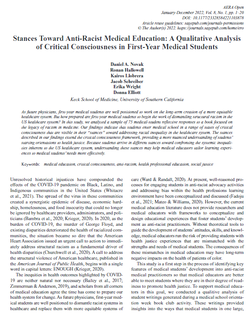
Abstract:
As future physicians, first-year medical students are well positioned to work on the long-term creation of a more equitable healthcare system. But how prepared are first-year medical students to begin the work of dismantling structural racism in the US healthcare system? In this study, we analyzed a sample of 75 medical-student reflective responses to a book focused on the legacy of racism in medicine. Our findings indicate that students enter medical school in a range of states of critical consciousness that are visible in their “stances” toward addressing racial inequality in the healthcare system. The stances described in our findings extend the critical consciousness framework, providing a more nuanced understanding of students’ starting orientations to health justice. Because students arrive in different stances toward confronting the systemic inequalities inherent to the US healthcare system, understanding these stances may help medical educators tailor learning experiences to medical students’ needs more effectively.
Citation:
Novak, D. A., Hallowell, R., Llobrera, K., Schreiber, J., Wright, E., & Elliott, D. (2022). Stances Toward Anti-Racist Medical Education: A Qualitative Analysis of Critical Consciousness in First-Year Medical Students. AERA Open, 8. https://doi.org/10.1177/23328584221103878
As future physicians, first-year medical students are well positioned to work on the long-term creation of a more equitable healthcare system. But how prepared are first-year medical students to begin the work of dismantling structural racism in the US healthcare system? In this study, we analyzed a sample of 75 medical-student reflective responses to a book focused on the legacy of racism in medicine. Our findings indicate that students enter medical school in a range of states of critical consciousness that are visible in their “stances” toward addressing racial inequality in the healthcare system. The stances described in our findings extend the critical consciousness framework, providing a more nuanced understanding of students’ starting orientations to health justice. Because students arrive in different stances toward confronting the systemic inequalities inherent to the US healthcare system, understanding these stances may help medical educators tailor learning experiences to medical students’ needs more effectively.
Citation:
Novak, D. A., Hallowell, R., Llobrera, K., Schreiber, J., Wright, E., & Elliott, D. (2022). Stances Toward Anti-Racist Medical Education: A Qualitative Analysis of Critical Consciousness in First-Year Medical Students. AERA Open, 8. https://doi.org/10.1177/23328584221103878
Expect What you inspect: A worked example of Dashboards that support continuous quality improvement in medical education (2020)
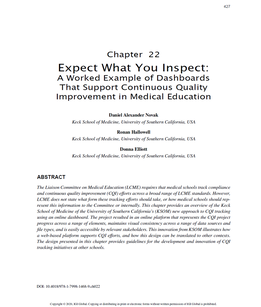
Abstract:
The Liaison Committee on Medical Education (LCME) requires that medical schools track compliance and continuous quality improvement (CQI) efforts across a broad range of LCME standards. However, LCME does not state what form these tracking efforts should take, or how medical schools should represent this information to the Committee or internally. This chapter provides an overview of the Keck School of Medicine of the University of Southern California’s (KSOM) new approach to CQI tracking using an online dashboard.
The project resulted in an online platform that represents the CQI project progress across a range of elements, maintains visual consistency across a range of data sources and file types, and is easily accessible by relevant stakeholders. This innovation from KSOM illustrates how a web-based platform supports CQI efforts, and how this design can be translated to other contexts. The design presented in this chapter provides guidelines for the development and innovation of CQI tracking initiatives at other schools.
Citation:
Novak DA, Hallowell R, Elliott D. Expect What You Inspect. Advances in Medical Education, Research, and Ethics Handbook of Research on the Efficacy of Training Programs and Systems in Medical Education. 2020:427-448. doi:10.4018/978-1-7998-1468-9.ch022.
The Liaison Committee on Medical Education (LCME) requires that medical schools track compliance and continuous quality improvement (CQI) efforts across a broad range of LCME standards. However, LCME does not state what form these tracking efforts should take, or how medical schools should represent this information to the Committee or internally. This chapter provides an overview of the Keck School of Medicine of the University of Southern California’s (KSOM) new approach to CQI tracking using an online dashboard.
The project resulted in an online platform that represents the CQI project progress across a range of elements, maintains visual consistency across a range of data sources and file types, and is easily accessible by relevant stakeholders. This innovation from KSOM illustrates how a web-based platform supports CQI efforts, and how this design can be translated to other contexts. The design presented in this chapter provides guidelines for the development and innovation of CQI tracking initiatives at other schools.
Citation:
Novak DA, Hallowell R, Elliott D. Expect What You Inspect. Advances in Medical Education, Research, and Ethics Handbook of Research on the Efficacy of Training Programs and Systems in Medical Education. 2020:427-448. doi:10.4018/978-1-7998-1468-9.ch022.
A Continuum of innovation: Curricular renewal strategies in Undergraduate medical education, 2010-2018 (2019)
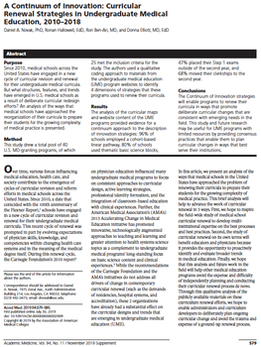
Abstract:
Purpose Since 2010, medical schools across the United States have engaged in a new cycle of curricular revision and renewal for their undergraduate medical curricula. But what structures, features, and trends have emerged in U.S. medical schools as a result of deliberate curricular redesign efforts? An analysis of the ways that medical schools have approached the reorganization of their curricula to prepare their students for the growing complexity of medical practice is presented.
Method This study drew a total pool of 40 U.S. MD-granting programs, of which 25 met the inclusion criteria for the study. The authors used a qualitative coding approach to materials from the undergraduate medical education (UME) program websites to identify 4 dimensions of strategies that these programs used to renew their curricula.
Results The analysis of the curricular maps and website content of the UME programs provided evidence for a continuum approach to the description of innovation strategies: 96% of schools employed a cohort-based linear pathway, 80% of schools used thematic basic science blocks, 47% placed their Step 1 exams outside of the second year, and 68% moved their clerkships to the second year.
Conclusions The Continuum of Innovation strategies will enable programs to renew their curricula in ways that promote deliberate curricular changes that are consistent with emerging needs in the field. This study and future research may be useful for UME programs with limited resources by providing consensus practices that enable them to plan curricular changes in way
Citation:
Novak DA, Hallowell R, Ben-Ari R, Elliott D. A Continuum of Innovation. Acad Med. 2019;94:S79-S85. doi:10.1097/ACM.0000000000002909
Purpose Since 2010, medical schools across the United States have engaged in a new cycle of curricular revision and renewal for their undergraduate medical curricula. But what structures, features, and trends have emerged in U.S. medical schools as a result of deliberate curricular redesign efforts? An analysis of the ways that medical schools have approached the reorganization of their curricula to prepare their students for the growing complexity of medical practice is presented.
Method This study drew a total pool of 40 U.S. MD-granting programs, of which 25 met the inclusion criteria for the study. The authors used a qualitative coding approach to materials from the undergraduate medical education (UME) program websites to identify 4 dimensions of strategies that these programs used to renew their curricula.
Results The analysis of the curricular maps and website content of the UME programs provided evidence for a continuum approach to the description of innovation strategies: 96% of schools employed a cohort-based linear pathway, 80% of schools used thematic basic science blocks, 47% placed their Step 1 exams outside of the second year, and 68% moved their clerkships to the second year.
Conclusions The Continuum of Innovation strategies will enable programs to renew their curricula in ways that promote deliberate curricular changes that are consistent with emerging needs in the field. This study and future research may be useful for UME programs with limited resources by providing consensus practices that enable them to plan curricular changes in way
Citation:
Novak DA, Hallowell R, Ben-Ari R, Elliott D. A Continuum of Innovation. Acad Med. 2019;94:S79-S85. doi:10.1097/ACM.0000000000002909
Exploring the Influence of Accomplished Teachers' Video and Commentary Pairing on Teacher Candidates' Noticing and Thinking about Practice (2018)
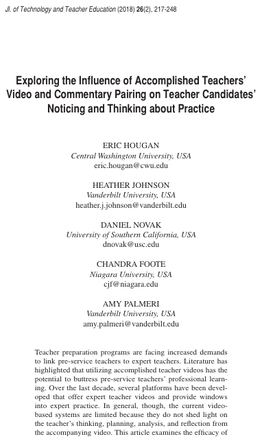
Abstract:
Teacher preparation programs are facing increased demands to link pre-service teachers to expert teachers. Literature has highlighted that utilizing accomplished teacher videos has the potential to buttress pre-service teachers’ professional learning. Over the last decade, several platforms have been developed that offer expert teacher videos and provide windows into expert practice. In general, though, the current video-based systems are limited because they do not shed light on the teacher’s thinking, planning, analysis, and reflection from the accompanying video. This article examines the efficacy of a platform that brings forward accomplished teachers’ thinking alongside their videos. The empirical evidence from this study indicated that, from the pre-service teachers’ perspective, the pairing of video and commentary helped them unpack the complexities of decision-making that accomplished teachers engage in when they plan, teach, and reflect on practice.
Citation:
Hougan, E., Johnson, H., Novak, D., Foote, C., & Palmeri, A. (2018). Exploring the Influence of Accomplished Teachers’ Video and Commentary Pairing on Teacher Candidates’ Noticing and Thinking about Practice. Journal of Technology and Teacher Education, 26(2), 217-248.
Teacher preparation programs are facing increased demands to link pre-service teachers to expert teachers. Literature has highlighted that utilizing accomplished teacher videos has the potential to buttress pre-service teachers’ professional learning. Over the last decade, several platforms have been developed that offer expert teacher videos and provide windows into expert practice. In general, though, the current video-based systems are limited because they do not shed light on the teacher’s thinking, planning, analysis, and reflection from the accompanying video. This article examines the efficacy of a platform that brings forward accomplished teachers’ thinking alongside their videos. The empirical evidence from this study indicated that, from the pre-service teachers’ perspective, the pairing of video and commentary helped them unpack the complexities of decision-making that accomplished teachers engage in when they plan, teach, and reflect on practice.
Citation:
Hougan, E., Johnson, H., Novak, D., Foote, C., & Palmeri, A. (2018). Exploring the Influence of Accomplished Teachers’ Video and Commentary Pairing on Teacher Candidates’ Noticing and Thinking about Practice. Journal of Technology and Teacher Education, 26(2), 217-248.
Inclusive Instructional Practices Used and Their Perceived Importance by Instructors (2017)
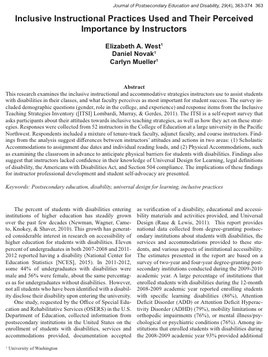
Abstract:
This research examines the inclusive instructional and accommodative strategies instructors use to assist students with disabilities in their classes, and what faculty perceives as most important for student success. The survey included demographic questions (gender, role in the college, and experience) and response items from the Inclusive Teaching Strategies Inventory ([ITSI] Lombardi, Murray, & Gerdes, 2011). The ITSI is a self-report survey that asks participants about their attitudes towards inclusive teaching strategies, as well as how they act on these strategies. Responses were collected from 52 instructors in the College of Education at a large university in the Pacific Northwest. Respondents included a mixture of tenure-track faculty, adjunct faculty, and course instructors.
Findings from the analysis suggest differences between instructors’ attitudes and actions in two areas: (1) Scholastic Accommodations to assignment due dates and individual reading loads, and (2) Physical Accommodations, such as examining the classroom in advance to anticipate physical barriers for students with disabilities. Findings also suggest that instructors lacked confidence in their knowledge of Universal Design for Learning, legal definitions of disability, the Americans with Disabilities Act, and Section 504 compliance. The implications of these findings for instructor professional development and student self-advocacy are presented.
Citation:
West, B., Novak. D., & Mueller, C. (2017). Inclusive Instructional Practices Used and Their Perceived Importance by Instructors. The Journal of Postsecondary Education and Disability, 29(4), 363-374.
This research examines the inclusive instructional and accommodative strategies instructors use to assist students with disabilities in their classes, and what faculty perceives as most important for student success. The survey included demographic questions (gender, role in the college, and experience) and response items from the Inclusive Teaching Strategies Inventory ([ITSI] Lombardi, Murray, & Gerdes, 2011). The ITSI is a self-report survey that asks participants about their attitudes towards inclusive teaching strategies, as well as how they act on these strategies. Responses were collected from 52 instructors in the College of Education at a large university in the Pacific Northwest. Respondents included a mixture of tenure-track faculty, adjunct faculty, and course instructors.
Findings from the analysis suggest differences between instructors’ attitudes and actions in two areas: (1) Scholastic Accommodations to assignment due dates and individual reading loads, and (2) Physical Accommodations, such as examining the classroom in advance to anticipate physical barriers for students with disabilities. Findings also suggest that instructors lacked confidence in their knowledge of Universal Design for Learning, legal definitions of disability, the Americans with Disabilities Act, and Section 504 compliance. The implications of these findings for instructor professional development and student self-advocacy are presented.
Citation:
West, B., Novak. D., & Mueller, C. (2017). Inclusive Instructional Practices Used and Their Perceived Importance by Instructors. The Journal of Postsecondary Education and Disability, 29(4), 363-374.
i-Leadership: Leadership Learning in the Millenial Generation (2017)
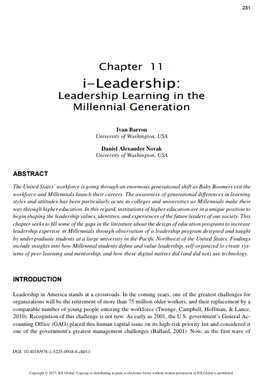
Abstract:
The United States’ workforce is going through an enormous generational shift as Baby Boomers exit the workforce and Millennials launch their careers. The awareness of generational differences in learning styles and attitudes has been particularly acute in colleges and universities as Millennials make their way through higher education. In this regard, institutions of higher education are in a unique position to begin shaping the leadership values, identities, and experiences of the future leaders of our society. This chapter seeks to fill some of the gaps in the literature about the design of education programs to increase leadership expertise in Millennials through observation of a leadership program designed and taught by undergraduate students at a large university in the Pacific Northwest of the United States. Findings include insights into how Millennial students define and value leadership, self-organized to create systems of peer learning and mentorship, and how these digital natives did (and did not) use technology.
Citation:
Barron, I., & Novak, D. A. (2017). i-Leadership: Leadership Learning in the Millennial Generation. In Handbook of Research on Human Resources Strategies for the New Millennial Workforce (pp. 231-257). IGI Global.
The United States’ workforce is going through an enormous generational shift as Baby Boomers exit the workforce and Millennials launch their careers. The awareness of generational differences in learning styles and attitudes has been particularly acute in colleges and universities as Millennials make their way through higher education. In this regard, institutions of higher education are in a unique position to begin shaping the leadership values, identities, and experiences of the future leaders of our society. This chapter seeks to fill some of the gaps in the literature about the design of education programs to increase leadership expertise in Millennials through observation of a leadership program designed and taught by undergraduate students at a large university in the Pacific Northwest of the United States. Findings include insights into how Millennial students define and value leadership, self-organized to create systems of peer learning and mentorship, and how these digital natives did (and did not) use technology.
Citation:
Barron, I., & Novak, D. A. (2017). i-Leadership: Leadership Learning in the Millennial Generation. In Handbook of Research on Human Resources Strategies for the New Millennial Workforce (pp. 231-257). IGI Global.
Mobile literacies: Learning in the Mobile Age (2015)
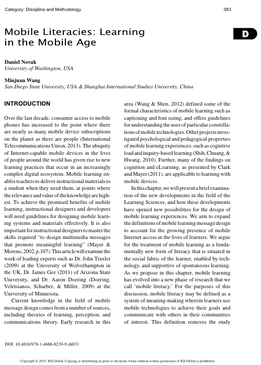
Click on the image to download the article
Abstract:
In this chapter, we will present a brief examination of the new developments in the field of the Learning Sciences, and how these developments have opened new possibilities for the design of mobile learning experiences. We aim to expand the definitions of mobile learning message design to account for the growing presence of mobile Internet access in the lives of learners. We argue for the treatment of mobile learning as a fundamentally new form of literacy that is situated in the social fabric of the learner, enabled by technology, and supportive of spontaneous learning. As we propose in this chapter, mobile learning has evolved into a new phase of research that we call ‘mobile literacy.’
Citation:
Novak, D., & Wang M. (2015). Mobile Literacies: Learning in the Mobile Age. In Z. Yan (Ed.), The Encyclopedia of Mobile Phone Behaviors. Hershey, PA: IGI Global.
In this chapter, we will present a brief examination of the new developments in the field of the Learning Sciences, and how these developments have opened new possibilities for the design of mobile learning experiences. We aim to expand the definitions of mobile learning message design to account for the growing presence of mobile Internet access in the lives of learners. We argue for the treatment of mobile learning as a fundamentally new form of literacy that is situated in the social fabric of the learner, enabled by technology, and supportive of spontaneous learning. As we propose in this chapter, mobile learning has evolved into a new phase of research that we call ‘mobile literacy.’
Citation:
Novak, D., & Wang M. (2015). Mobile Literacies: Learning in the Mobile Age. In Z. Yan (Ed.), The Encyclopedia of Mobile Phone Behaviors. Hershey, PA: IGI Global.
LOOKING IN, LOOKING OUT: A DISCUSSION OF THE EDUCATIONAL AFFORDANCES OF CURRENT MOBILE AUGMENTED REALITY TECHNOLOGIES (2012)
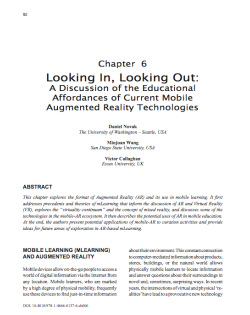
Click on the image to download the article
Abstract:
This chapter explores the format of Augmented Reality (AR) and its use in mobile learning. It first addresses precedents and theories of mLearning that inform the discussion of AR and Virtual Reality (VR), explores the “virtuality continuum” and the concept of mixed reality, and discusses some of the technologies in the mobile-AR ecosystem. It then describes the potential uses of AR in mobile education. At the end, the authors present potential applications of mobile-AR to curation activities and provide ideas for future areas of exploration in AR-based mLearning.
Citation:
NOVAK, D., WANG, M., & CALLAGHAN, V. (2012). LOOKING IN, LOOKING OUT: A DISCUSSION OF THE EDUCATIONAL AFFORDANCES OF CURRENT MOBILE AUGMENTED REALITY TECHNOLOGIES. IN J. JIA (ED.), EDUCATIONAL STAGES AND INTERACTIVE LEARNING: FROM KINDERGARTEN TO WORKPLACE LEARNING. HERSHEY, PA: IGI GLOBAL.
This chapter explores the format of Augmented Reality (AR) and its use in mobile learning. It first addresses precedents and theories of mLearning that inform the discussion of AR and Virtual Reality (VR), explores the “virtuality continuum” and the concept of mixed reality, and discusses some of the technologies in the mobile-AR ecosystem. It then describes the potential uses of AR in mobile education. At the end, the authors present potential applications of mobile-AR to curation activities and provide ideas for future areas of exploration in AR-based mLearning.
Citation:
NOVAK, D., WANG, M., & CALLAGHAN, V. (2012). LOOKING IN, LOOKING OUT: A DISCUSSION OF THE EDUCATIONAL AFFORDANCES OF CURRENT MOBILE AUGMENTED REALITY TECHNOLOGIES. IN J. JIA (ED.), EDUCATIONAL STAGES AND INTERACTIVE LEARNING: FROM KINDERGARTEN TO WORKPLACE LEARNING. HERSHEY, PA: IGI GLOBAL.
MOBILE LEARNING IN A LARGE BLENDED COMPUTER SCIENCE CLASSROOM: SYSTEM FUNCTION, PEDAGOGIES, AND THEIR IMPACT ON LEARNINg (2009)
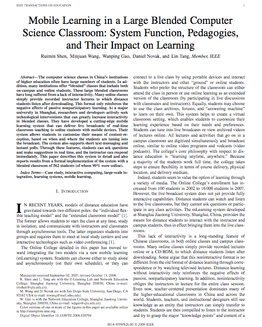
Click the image to download the article
Abstract:
The computer science classes in China’s institutions of higher education often have large numbers of students. In addition, many institutions offer “blended” classes that include both on-campus and online students. At a major university in Shanghai, researchers and developers actively seek technological interventions that can greatly increase interactivity in blended classes. They have developed a cutting-edge mobile learning system that can deliver live broadcasts of real-time classroom teaching to online students with mobile devices. his paper describes this system in detail and also reports results from a formal implementation of the system with a blended classroom of 562 students (of whom 90% were online).
Citation:
SHEN, R. M., WANG, M. J., GAO, W. P., NOVAK, D., & TANG, L. (2009). MOBILE LEARNING IN A LARGE BLENDED COMPUTER SCIENCE CLASSROOM: SYSTEM FUNCTION, PEDAGOGIES, AND THEIR IMPACT ON LEARNING. IEEE TRANSACTIONS ON EDUCATION, 52(4), 538-546.
The computer science classes in China’s institutions of higher education often have large numbers of students. In addition, many institutions offer “blended” classes that include both on-campus and online students. At a major university in Shanghai, researchers and developers actively seek technological interventions that can greatly increase interactivity in blended classes. They have developed a cutting-edge mobile learning system that can deliver live broadcasts of real-time classroom teaching to online students with mobile devices. his paper describes this system in detail and also reports results from a formal implementation of the system with a blended classroom of 562 students (of whom 90% were online).
Citation:
SHEN, R. M., WANG, M. J., GAO, W. P., NOVAK, D., & TANG, L. (2009). MOBILE LEARNING IN A LARGE BLENDED COMPUTER SCIENCE CLASSROOM: SYSTEM FUNCTION, PEDAGOGIES, AND THEIR IMPACT ON LEARNING. IEEE TRANSACTIONS ON EDUCATION, 52(4), 538-546.
THE IMPACT OF MOBILE LEARNING ON STUDENTS’ LEARNING BEHAVIOURS AND PERFORMANCE: REPORT FROM A LARGE BLENDED CLASSROOM (2009)
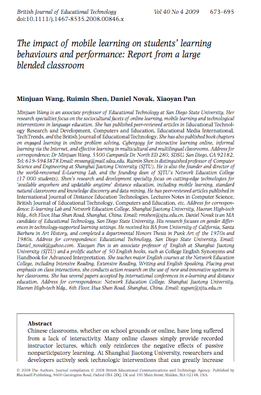
Click the image to download the article
Abstract:
Chinese classrooms, whether on school grounds or online, have long suffered from a lack of interactivity. Many online classes simply provide recorded instructor lectures, which only reinforces the negative effects of passive nonparticipatory learning. At Shanghai Jiaotong University, researchers and developers actively seek technological interventions that can greatly increase interactivity in large blended classes. They developed a cutting-edge mobile learning system that can deliver live broadcasts of real-time classroom teaching to students with mobile devices. This article describes this system in detail, and also reports results from a formal imple- mentation of the system in a blended English classroom of 1000 students (with about 800 being online).
Citation:
WANG, M., SHEN, R., NOVAK, D., & PAN, X. (2009). THE IMPACT OF MOBILE LEARNING ON STUDENTS’ LEARNING BEHAVIOURS AND PERFORMANCE: REPORT FROM A LARGE BLENDED CLASSROOM. BRITISH JOURNAL OF EDUCATIONAL TECHNOLOGY, 40(4), 673–695.
Chinese classrooms, whether on school grounds or online, have long suffered from a lack of interactivity. Many online classes simply provide recorded instructor lectures, which only reinforces the negative effects of passive nonparticipatory learning. At Shanghai Jiaotong University, researchers and developers actively seek technological interventions that can greatly increase interactivity in large blended classes. They developed a cutting-edge mobile learning system that can deliver live broadcasts of real-time classroom teaching to students with mobile devices. This article describes this system in detail, and also reports results from a formal imple- mentation of the system in a blended English classroom of 1000 students (with about 800 being online).
Citation:
WANG, M., SHEN, R., NOVAK, D., & PAN, X. (2009). THE IMPACT OF MOBILE LEARNING ON STUDENTS’ LEARNING BEHAVIOURS AND PERFORMANCE: REPORT FROM A LARGE BLENDED CLASSROOM. BRITISH JOURNAL OF EDUCATIONAL TECHNOLOGY, 40(4), 673–695.
CHARACTERISTICS AFFECTING LEARNER PARTICIPATION IN LARGE HYBRID CLASSROOMS (2009)
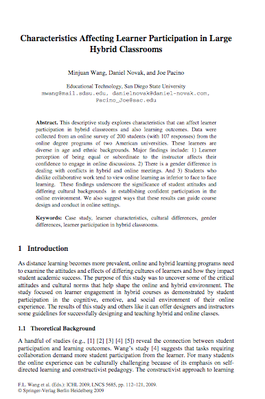
Click the image to download the article
Abstract:
This descriptive study explores characteristics that can affect learner
participation in hybrid classrooms and also learning outcomes. Data were collected from an online survey of 200 students (with 107 responses) from the online degree programs of two American universities. These learners are diverse in age and ethnic backgrounds. Major findings include: 1) Learner perception of being equal or subordinate to the instructor affects their confidence to engage in online discussions. 2) There is a gender difference in
dealing with conflicts in hybrid and online meetings. 3) Students who dislike collaborative work tend to view online learning as inferior to face to face learning. These findings underscore the significance of student attitudes and differing cultural backgrounds in establishing confident participation in the online environment. We also suggest ways that these results can guide course design and conduct in online settings.
Citation:
WANG, M., NOVAK, D., & PACINO, J. (2009). CHARACTERISTICS AFFECTING LEARNER PARTICIPATION IN LARGE HYBRID CLASSROOMS. LECTURE NOTES IN COMPUTER SCIENCE: THEORETICAL COMPUTER SCIENCE AND GENERAL ISSUE S, 5685, 112-121.
This descriptive study explores characteristics that can affect learner
participation in hybrid classrooms and also learning outcomes. Data were collected from an online survey of 200 students (with 107 responses) from the online degree programs of two American universities. These learners are diverse in age and ethnic backgrounds. Major findings include: 1) Learner perception of being equal or subordinate to the instructor affects their confidence to engage in online discussions. 2) There is a gender difference in
dealing with conflicts in hybrid and online meetings. 3) Students who dislike collaborative work tend to view online learning as inferior to face to face learning. These findings underscore the significance of student attitudes and differing cultural backgrounds in establishing confident participation in the online environment. We also suggest ways that these results can guide course design and conduct in online settings.
Citation:
WANG, M., NOVAK, D., & PACINO, J. (2009). CHARACTERISTICS AFFECTING LEARNER PARTICIPATION IN LARGE HYBRID CLASSROOMS. LECTURE NOTES IN COMPUTER SCIENCE: THEORETICAL COMPUTER SCIENCE AND GENERAL ISSUE S, 5685, 112-121.
ASSESSING THE EFFECTIVENESS OF MOBILE LEARNING IN LARGE HYBRID/BLENDED LEARNING CLASSROOMS (2008)
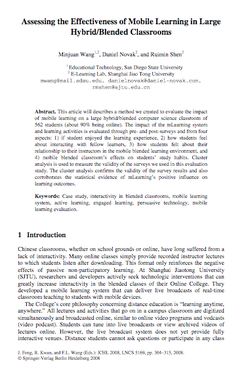
Click the image to download the article
Abstract:
This article will describes a method we created to evaluate the impact of mobile learning on a large hybrid/blended computer science classroom of 562 students (about 90% being online). The impact of the mLearning system and learning activities is evaluated through pre- and post-surveys and from four aspects: 1) if student enjoyed the learning experience, 2) how students feel about interacting with fellow learners, 3) how students felt about their relationship to their instructors in the mobile blended learning environment, and 4) mobile blended classroom’s effects on students’ study habits. Cluster analysis is used to measure the validity of the surveys we used in this evaluation study.
Citation:
WANG, M. J., SHEN, R. M., & NOVAK, D. (2008). ASSESSING THE EFFECTIVENESS OF MOBILE LEARNING IN LARGE HYBRID/BLENDED LEARNING CLASSROOMS. LECTURE NOTES IN COMPUTER SCIENCE: THEORETICAL COMPUTER SCIENCE AND GENERAL ISSUES, 5169, 304-315.
This article will describes a method we created to evaluate the impact of mobile learning on a large hybrid/blended computer science classroom of 562 students (about 90% being online). The impact of the mLearning system and learning activities is evaluated through pre- and post-surveys and from four aspects: 1) if student enjoyed the learning experience, 2) how students feel about interacting with fellow learners, 3) how students felt about their relationship to their instructors in the mobile blended learning environment, and 4) mobile blended classroom’s effects on students’ study habits. Cluster analysis is used to measure the validity of the surveys we used in this evaluation study.
Citation:
WANG, M. J., SHEN, R. M., & NOVAK, D. (2008). ASSESSING THE EFFECTIVENESS OF MOBILE LEARNING IN LARGE HYBRID/BLENDED LEARNING CLASSROOMS. LECTURE NOTES IN COMPUTER SCIENCE: THEORETICAL COMPUTER SCIENCE AND GENERAL ISSUES, 5169, 304-315.
GENDER, SEX, AND CONFLICT IN THE ONLINE CLASSROOM (2008)
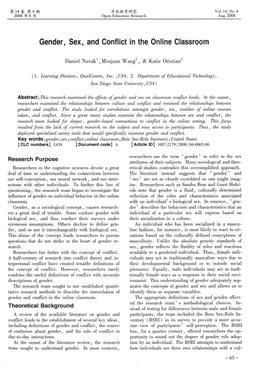
Click the image to download the article
Abstract:
This research examined the effects of gender and sex on classroom conflict levels. At the outset, researchers examined the relationships between culture and conflict and reviewed the relationships between gender and conflict. The study looked for correlations amongst gender, sex, number of online courses taken, and perceived level of conflict that arose in online forums and classes.
Citation:
NOVAK, D., WANG, M., & ORISTIAN. (2008). GENDER, SEX, AND CONFLICT IN THE ONLINE CLASSROOM. OPEN EDUCATION RESEARCH, 14(4), 65–69.
This research examined the effects of gender and sex on classroom conflict levels. At the outset, researchers examined the relationships between culture and conflict and reviewed the relationships between gender and conflict. The study looked for correlations amongst gender, sex, number of online courses taken, and perceived level of conflict that arose in online forums and classes.
Citation:
NOVAK, D., WANG, M., & ORISTIAN. (2008). GENDER, SEX, AND CONFLICT IN THE ONLINE CLASSROOM. OPEN EDUCATION RESEARCH, 14(4), 65–69.